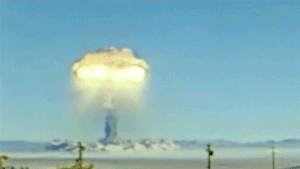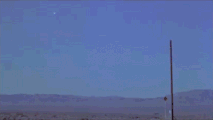Operation Buster–Jangle was a series of seven (six atmospheric, one cratering) nuclear weapons tests conducted by the United States in late 1951 at the Nevada Test Site. Buster–Jangle was the first joint test program between the DOD (Operation Buster) and Los Alamos National Laboratories (Operation Jangle). As part of Operation Buster, 6,500 troops were involved in the Operation Desert Rock I, II, and III exercises in conjunction with the tests.[1] The last two tests, Operation Jangle, evaluated the cratering effects of low-yield nuclear devices. This series preceded Operation Tumbler–Snapper and followed Operation Greenhouse.
| Operation Buster–Jangle | |
|---|---|
 Buster–Jangle Easy, 31 kilotons. | |
| Information | |
| Country | United States |
| Test site | NTS, Areas 1–4, 6–10, Yucca Flat |
| Period | 1951 |
| Number of tests | 7 |
| Test type | cratering, dry surface, free air drop, tower |
| Max. yield | 31 kilotonnes of TNT (130 TJ) |
| Test series chronology | |

US ground forces involvement
Four U.S. Army units took part in the Operation Buster–Jangle "Dog" test for combat maneuvers after the detonation of a nuclear weapon took place. These units consisted of:
- 1st Battalion 188th Airborne Infantry Regiment 11th Airborne Division
- 3rd Medical Platoon 188th Airborne Medical Company
- Platoon Company A 127th Engineer Battalion
- Battery C 546th Field Artillery Battalion
Personnel were instructed to create foxholes and construct gun emplacements and bunkers in a defensive position 11 km south of the detonation area. After the nuclear bomb was detonated, the troops were ordered to move forward towards the affected area. While traveling closer to ground zero, troops witnessed the nuclear weapon's effects on the fortifications that were placed in the location in preparation for the tests. The ground troops got as close as 900 meters from ground zero before they were instructed to move out of the area. The Human Resources Research Office was tasked with gathering data on the psychological experiences of the troops after witnessing such a detonation and moving closer towards the affected area.[1]
Radiation protection standards
For the Operation Buster–Jangle series of tests, the Atomic Energy Commission created a set of criteria that must be followed if exposing armed forces, or civilians to the harmful effects of ionizing radiation.
- Orientation and proper radiological training
- Dispersion of dosimeters amongst personnel
- Utilization of radiological protective equipment and clothing
- Active monitoring of radiological levels
- Briefing of personnel taking part in the exercise
- Decontamination of radioactive debris
A majority of the personnel that took part in the exercise received around 3 R, with pilots receiving an average of 3.9 R. These estimates vary given the differing data provided by the Department of Defense over the years.[1]
| Name [note 1] | Date time (UT) | Local time zone[note 2][2] | Location[note 3] | Elevation + height [note 4] | Delivery,[note 5] Purpose [note 6] | Device[note 7] | Yield[note 8] | Fallout[note 9] | References | Notes |
|---|---|---|---|---|---|---|---|---|---|---|
| Able | October 22, 1951 14:00:00.0 | PST (−8 hrs) | NTS Area 7 37°05′02″N 116°01′29″W / 37.0838°N 116.0248°W | 1,280 m (4,200 ft) + 30 m (98 ft) | tower, weapons development | Mk-6 "Puny Plutonium" | 0.05 kt | [3][4][5][6][7] | Minimum mass design, fizzle (yield "less than a pound"); yet it yielded a lower bound on viable plutonium mass. October 19 attempt failed due to control wiring problem. | |
| Baker | October 28, 1951 15:20:08.9 | PST (−8 hrs) | NTS Area 7 37°05′06″N 116°01′15″W / 37.085°N 116.0209°W | 1,280 m (4,200 ft) + 340 m (1,120 ft) | free air drop, weapons development | Mk-4 "LT" | 3.5 kt | I-131 venting detected, 600 kCi (22,000 TBq) | [3][4][5][6][8] | No uranium tamper. |
| Charlie | October 30, 1951 15:00:29.8 | PST (−8 hrs) | NTS Area 7 37°05′06″N 116°01′16″W / 37.085°N 116.0211°W | 1,280 m (4,200 ft) + 350 m (1,150 ft) | free air drop, weapons development | Mk-4 "PC" | 14 kt | I-131 venting detected, 2 MCi (74 PBq) | [3][4][5][6][8] | |
| Dog | November 1, 1951 15:30:01.6 | PST (−8 hrs) | NTS Area 7 37°05′05″N 116°01′14″W / 37.0847°N 116.0206°W | 1,280 m (4,200 ft) + 430 m (1,410 ft) | free air drop, weapons development | Mk-4 "NF" | 21 kt | I-131 venting detected, 3.1 MCi (110 PBq) | [3][4][5][6][8] | Desert Rock I, no fallout (air burst). Troops trucked into defensive emplacements from 6 mi (9.7 km) observation point, held maneuvers. |
| Easy | November 5, 1951 16:29:58.2 | PST (−8 hrs) | NTS Area 7 37°05′31″N 116°01′31″W / 37.0919°N 116.0253°W | 1,280 m (4,200 ft) + 400 m (1,300 ft) | free air drop, weapons development | TX-7E | 31 kt | I-131 venting detected, 4.6 MCi (170 PBq) | [3][4][5][6][8] | First test of a tactical nuclear weapon. Air dropped from a B-45 Tornado. |
| Sugar | November 19, 1951 16:59:59.7 | PST (−8 hrs) | NTS Area 9 37°07′53″N 116°02′22″W / 37.13151°N 116.03947°W | 1,280 m (4,200 ft) + 1.1 m (3 ft 7 in) | dry surface, weapon effect | Mk-6 "Johnny" | 1.2 kt | I-131 venting detected, 170 kCi (6,300 TBq) | [3][4][5][6][8][9] | "Surface" shot. Only true surface shot in CONUS history along with Little Feller I & II Desert Rock II; maneuvers conducted at a distance due to dirtiness. |
| Uncle | November 29, 1951 19:59:59.7 | PST (−8 hrs) | NTS Area 10 37°10′11″N 116°02′36″W / 37.1697°N 116.0434°W | 1,283 m (4,209 ft) - 5 m (16 ft) | cratering, weapon effect | Mk-6 "Frankie" | 1.2 kt | I-131 venting detected, 170 kCi (6,300 TBq) | [3][4][5][6][8] | Cratering shot, meant to simulate 23 kt ground penetrating weapon. Desert Rock III, observed at 5 mi (8.0 km), kept distance in maneuvers. 5000 R/Hr near GZ one hour after shot. |
Gallery
- Buster-Jangle Charlie, 14-kilotons.
- Buster-Jangle Easy, 31-kilotons.
- Buster-Jangle Baker, 3.5-kilotons.
- Buster-Jangle Sugar, 1.2-kilotons.
References

- Griggs, D. T.; Frank Press (1961). "Probing the earth with nuclear explosions". Journal of Geophysical Research. 66 (1): 237–258. Bibcode:1961JGR....66..237G. doi:10.1029/jz066i001p00237. hdl:2027/mdp.39015077588872.
External links
- Nuclear Test Film – Operation Ranger, Operation Buster/Jangle (1951) is available for free viewing and download at the Internet Archive



